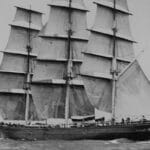
Global charity requests donations for historic maritime collection

Lloyd’s Register Foundation’s Heritage and Education Centre (HEC) is seeking donations of archival material and artefacts from businesses and the public to enhance its maritime history collection. This request follows the completion of a major project to digitise and catalogue the centre’s extensive Ship Plan and Survey Report Collection.
This collection, which spans from the 1830s to the 1970s, includes over 1.15 million records related to the design, construction, and maintenance of ships classified by Lloyd’s Register, which is a leading provider of compliance and classification services to the marine and offshore industries.
The collection contains records of well-known vessels and innovative designs, such as the Carpathia, the Cunard passenger liner that rescued survivors of the Titanic, and the Cutty Sark, one of the fastest tea clippers ever built, now displayed at Greenwich, London. It also documents significant milestones in the shipping industry, including the shift from steam to motor vessels and the adoption of new shipbuilding technologies. Examples include the Vulcanus, one of the first ships with a Diesel engine, and the Fullagar, the first ship with a welded hull. Additionally, wreck data, correspondence, photographs, and certificates have been digitised.

Noordam propeller being fitted.
HEC is now encouraging businesses and individuals to make contributions. The focus is on items related to maritime technology, engineering, safety and Lloyd’s Register’s history. All donations must meet the collecting criteria outlined in the centre’s acquisition and disposals policy. These criteria include records or objects connected to significant individuals associated with Lloyd’s Register, material related to ship and yacht building from the 18th century onwards, and items that highlight milestone events in the history of Lloyd’s Register.
Senior Archivist for the centre, Max Wilson, says: “We find that private or business collections are typically most at risk as archives are often thrown away to make room for other documentation. But this material is vital for learning from the past and improving maritime safety for the future.
“If there are any businesses, organisations or individuals personally that have maritime archives, of any kind, we would be more than happy to take a look. Archiving this kind of material preserves it for future generations and makes maritime history accessible to everybody.”

British freighter Seistan, which exploded in the Sitra Anchorage off Bahrain in 1958.
The HEC maritime archives aim to expand through public and private donations, contributing to a comprehensive understanding of maritime safety history. Later this year, HEC will launch its new online Collection Management System, making Lloyd’s Register Foundation’s archive, library, and heritage asset collections accessible to the public. This system will offer structured catalogue data and imagery from Lloyd’s Register’s history, amalgamated company records, and donated private collections, much of which has not been previously available.
In addition, HEC plans to open its archive and library collections to the public next spring in newly created reading rooms at Lloyd’s Register’s historic offices at 71 Fenchurch Street, London. This move marks one of the largest archive and library relocations back to the City of London in two decades.

Yacht registers.
The HEC team welcomes anyone with an archive collection to get in touch.
The online collection is freely available via the Lloyd’s Register Foundation Heritage and Education Centre’s website.
The post Global charity requests donations for historic maritime collection appeared first on Marine Industry News.
